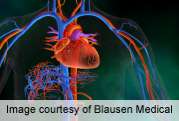(HealthDay)—For patients with ST-segment elevation myocardial infarction, a pharmacoinvasive strategy after fibrinolysis is beneficial for smokers and nonsmokers, according to a study published in the Oct. 1 issue of The American Journal of Cardiology.
Nigel S. Tan, M.D., from St. Michael's Hospital in Toronto, and colleagues examined whether the optimal treatment strategy after fibrinolysis differs based on smoking status. Data were collected from patients with ST-segment elevation myocardial infarction who were randomized to a routine early invasive (pharmacoinvasive) versus a standard (early transfer only for rescue percutaneous coronary intervention or delayed angiography) strategy after fibrinolysis. The interaction between smoking status and treatment strategy was examined.
The researchers found that after multivariate adjustment, smoking status was not a significant predictor of either primary or secondary end points. Compared with standard therapy, pharmacoinvasive management reduced the primary end point in smokers (7.7 versus 13.6 percent; P = 0.04) and in nonsmokers (13.1 versus 19.7 percent; P = 0.03). The effect of treatment was not modified by smoking status for any measured outcomes (P > 0.10 for all).
"The beneficial treatment effect of a pharmacoinvasive strategy is consistent in smokers and nonsmokers," the authors write.
The trial was partially funded by a grant from Roche; coronary stents were provided free of charge by Abbott. Several authors disclosed financial ties to the pharmaceutical industry.
More information:
Abstract
Full Text (subscription or payment may be required)
Journal information: American Journal of Cardiology
Copyright © 2014 HealthDay. All rights reserved.























